Managing Change at Starbucks: A Case Study for MGMT 582 Course
VerifiedAdded on 2022/08/24
|6
|1169
|12
Case Study
AI Summary
This case study analyzes Starbucks' approach to managing change, focusing on the application of human relation theory, contingency theory, and organizational learning. The report examines the company's attempts to implement changes, particularly in response to incidents related to bias and employee training. It highlights the limitations of human relation theory in the context of Starbucks, where employee motivation and participation were insufficient. The analysis further explores the contingency theory, emphasizing the importance of adapting strategies to specific circumstances. The case study evaluates the pros and cons of the implemented strategies, concluding that while contingency theory provided some insights, the company's reliance on training and relationship-building was not effective due to the lack of formal structure and weak internal communication. The study recommends a shift towards a more formalized structure and strengthened internal communication channels to address the issues faced by Starbucks.
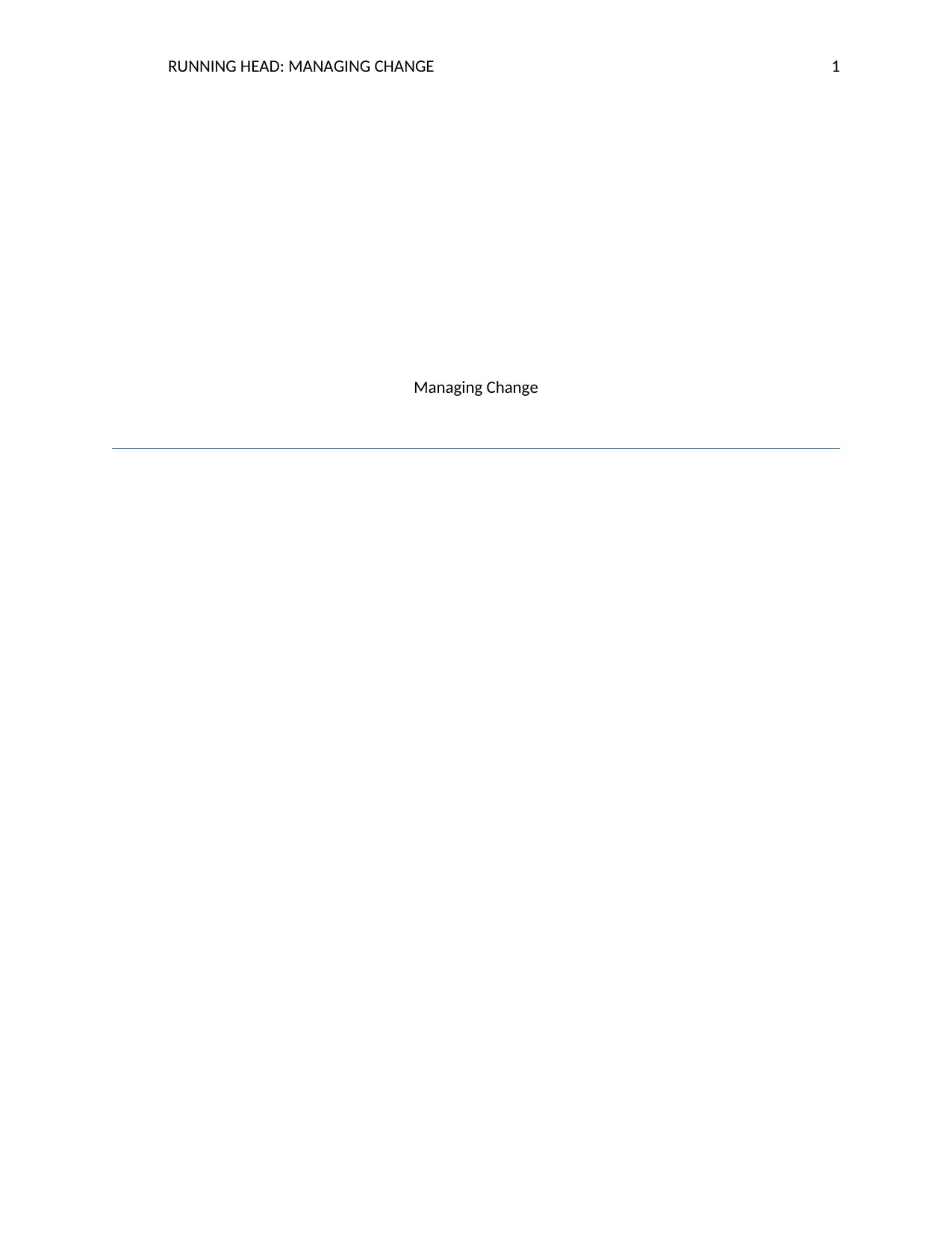
RUNNING HEAD: MANAGING CHANGE 1
Managing Change
Managing Change
Paraphrase This Document
Need a fresh take? Get an instant paraphrase of this document with our AI Paraphraser
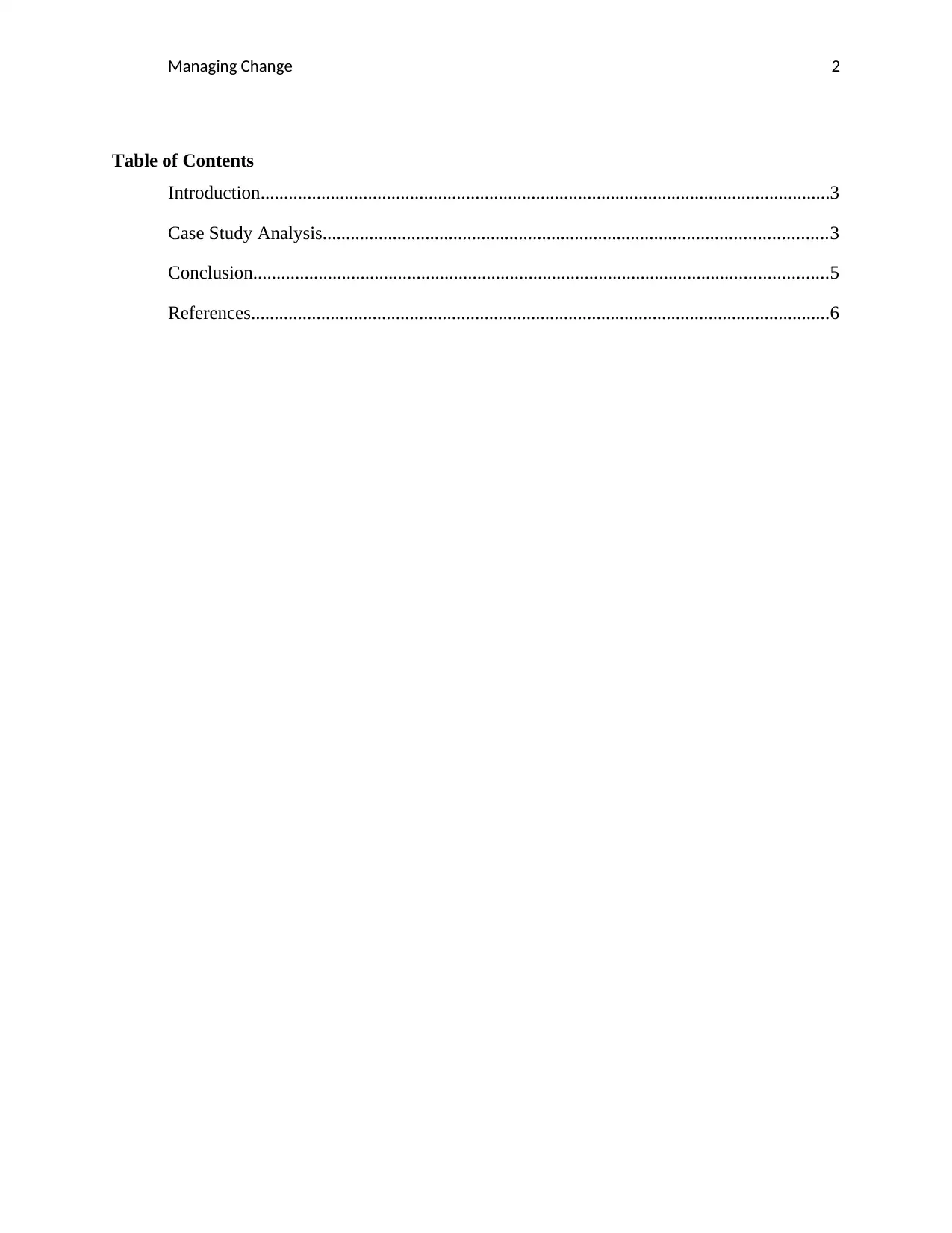
Managing Change 2
Table of Contents
Introduction..........................................................................................................................3
Case Study Analysis............................................................................................................3
Conclusion...........................................................................................................................5
References............................................................................................................................6
Table of Contents
Introduction..........................................................................................................................3
Case Study Analysis............................................................................................................3
Conclusion...........................................................................................................................5
References............................................................................................................................6
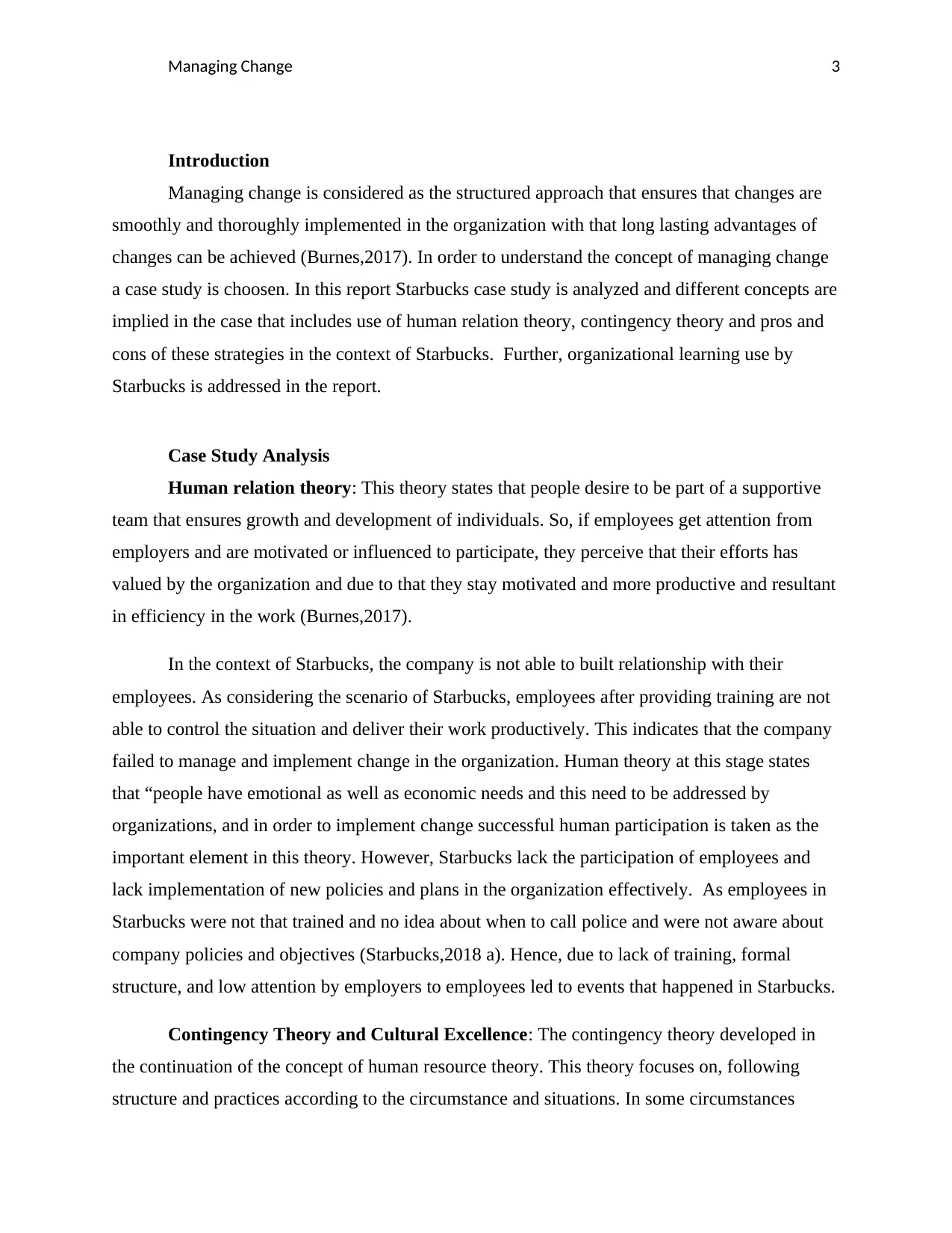
Managing Change 3
Introduction
Managing change is considered as the structured approach that ensures that changes are
smoothly and thoroughly implemented in the organization with that long lasting advantages of
changes can be achieved (Burnes,2017). In order to understand the concept of managing change
a case study is choosen. In this report Starbucks case study is analyzed and different concepts are
implied in the case that includes use of human relation theory, contingency theory and pros and
cons of these strategies in the context of Starbucks. Further, organizational learning use by
Starbucks is addressed in the report.
Case Study Analysis
Human relation theory: This theory states that people desire to be part of a supportive
team that ensures growth and development of individuals. So, if employees get attention from
employers and are motivated or influenced to participate, they perceive that their efforts has
valued by the organization and due to that they stay motivated and more productive and resultant
in efficiency in the work (Burnes,2017).
In the context of Starbucks, the company is not able to built relationship with their
employees. As considering the scenario of Starbucks, employees after providing training are not
able to control the situation and deliver their work productively. This indicates that the company
failed to manage and implement change in the organization. Human theory at this stage states
that “people have emotional as well as economic needs and this need to be addressed by
organizations, and in order to implement change successful human participation is taken as the
important element in this theory. However, Starbucks lack the participation of employees and
lack implementation of new policies and plans in the organization effectively. As employees in
Starbucks were not that trained and no idea about when to call police and were not aware about
company policies and objectives (Starbucks,2018 a). Hence, due to lack of training, formal
structure, and low attention by employers to employees led to events that happened in Starbucks.
Contingency Theory and Cultural Excellence: The contingency theory developed in
the continuation of the concept of human resource theory. This theory focuses on, following
structure and practices according to the circumstance and situations. In some circumstances
Introduction
Managing change is considered as the structured approach that ensures that changes are
smoothly and thoroughly implemented in the organization with that long lasting advantages of
changes can be achieved (Burnes,2017). In order to understand the concept of managing change
a case study is choosen. In this report Starbucks case study is analyzed and different concepts are
implied in the case that includes use of human relation theory, contingency theory and pros and
cons of these strategies in the context of Starbucks. Further, organizational learning use by
Starbucks is addressed in the report.
Case Study Analysis
Human relation theory: This theory states that people desire to be part of a supportive
team that ensures growth and development of individuals. So, if employees get attention from
employers and are motivated or influenced to participate, they perceive that their efforts has
valued by the organization and due to that they stay motivated and more productive and resultant
in efficiency in the work (Burnes,2017).
In the context of Starbucks, the company is not able to built relationship with their
employees. As considering the scenario of Starbucks, employees after providing training are not
able to control the situation and deliver their work productively. This indicates that the company
failed to manage and implement change in the organization. Human theory at this stage states
that “people have emotional as well as economic needs and this need to be addressed by
organizations, and in order to implement change successful human participation is taken as the
important element in this theory. However, Starbucks lack the participation of employees and
lack implementation of new policies and plans in the organization effectively. As employees in
Starbucks were not that trained and no idea about when to call police and were not aware about
company policies and objectives (Starbucks,2018 a). Hence, due to lack of training, formal
structure, and low attention by employers to employees led to events that happened in Starbucks.
Contingency Theory and Cultural Excellence: The contingency theory developed in
the continuation of the concept of human resource theory. This theory focuses on, following
structure and practices according to the circumstance and situations. In some circumstances
⊘ This is a preview!⊘
Do you want full access?
Subscribe today to unlock all pages.

Trusted by 1+ million students worldwide
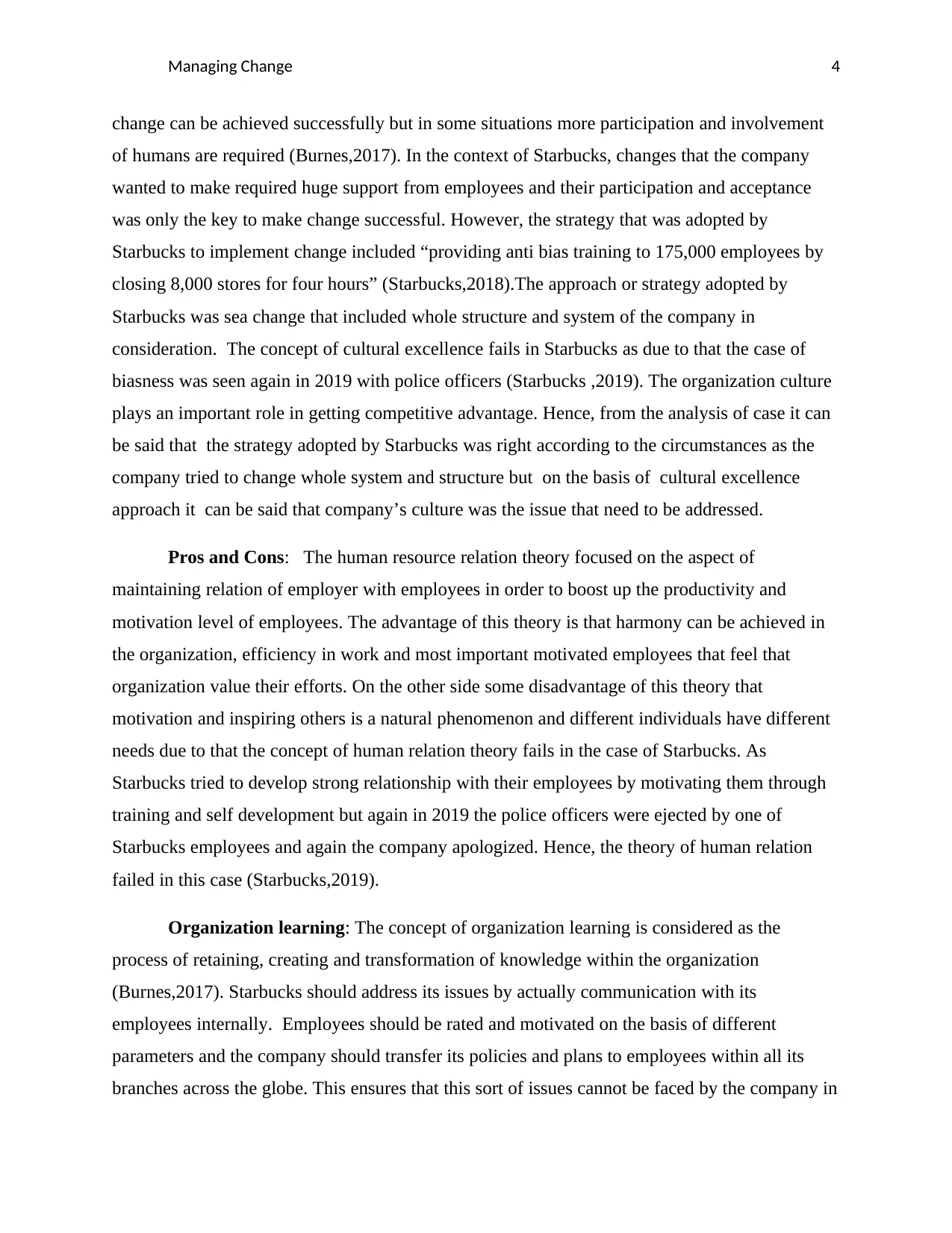
Managing Change 4
change can be achieved successfully but in some situations more participation and involvement
of humans are required (Burnes,2017). In the context of Starbucks, changes that the company
wanted to make required huge support from employees and their participation and acceptance
was only the key to make change successful. However, the strategy that was adopted by
Starbucks to implement change included “providing anti bias training to 175,000 employees by
closing 8,000 stores for four hours” (Starbucks,2018).The approach or strategy adopted by
Starbucks was sea change that included whole structure and system of the company in
consideration. The concept of cultural excellence fails in Starbucks as due to that the case of
biasness was seen again in 2019 with police officers (Starbucks ,2019). The organization culture
plays an important role in getting competitive advantage. Hence, from the analysis of case it can
be said that the strategy adopted by Starbucks was right according to the circumstances as the
company tried to change whole system and structure but on the basis of cultural excellence
approach it can be said that company’s culture was the issue that need to be addressed.
Pros and Cons: The human resource relation theory focused on the aspect of
maintaining relation of employer with employees in order to boost up the productivity and
motivation level of employees. The advantage of this theory is that harmony can be achieved in
the organization, efficiency in work and most important motivated employees that feel that
organization value their efforts. On the other side some disadvantage of this theory that
motivation and inspiring others is a natural phenomenon and different individuals have different
needs due to that the concept of human relation theory fails in the case of Starbucks. As
Starbucks tried to develop strong relationship with their employees by motivating them through
training and self development but again in 2019 the police officers were ejected by one of
Starbucks employees and again the company apologized. Hence, the theory of human relation
failed in this case (Starbucks,2019).
Organization learning: The concept of organization learning is considered as the
process of retaining, creating and transformation of knowledge within the organization
(Burnes,2017). Starbucks should address its issues by actually communication with its
employees internally. Employees should be rated and motivated on the basis of different
parameters and the company should transfer its policies and plans to employees within all its
branches across the globe. This ensures that this sort of issues cannot be faced by the company in
change can be achieved successfully but in some situations more participation and involvement
of humans are required (Burnes,2017). In the context of Starbucks, changes that the company
wanted to make required huge support from employees and their participation and acceptance
was only the key to make change successful. However, the strategy that was adopted by
Starbucks to implement change included “providing anti bias training to 175,000 employees by
closing 8,000 stores for four hours” (Starbucks,2018).The approach or strategy adopted by
Starbucks was sea change that included whole structure and system of the company in
consideration. The concept of cultural excellence fails in Starbucks as due to that the case of
biasness was seen again in 2019 with police officers (Starbucks ,2019). The organization culture
plays an important role in getting competitive advantage. Hence, from the analysis of case it can
be said that the strategy adopted by Starbucks was right according to the circumstances as the
company tried to change whole system and structure but on the basis of cultural excellence
approach it can be said that company’s culture was the issue that need to be addressed.
Pros and Cons: The human resource relation theory focused on the aspect of
maintaining relation of employer with employees in order to boost up the productivity and
motivation level of employees. The advantage of this theory is that harmony can be achieved in
the organization, efficiency in work and most important motivated employees that feel that
organization value their efforts. On the other side some disadvantage of this theory that
motivation and inspiring others is a natural phenomenon and different individuals have different
needs due to that the concept of human relation theory fails in the case of Starbucks. As
Starbucks tried to develop strong relationship with their employees by motivating them through
training and self development but again in 2019 the police officers were ejected by one of
Starbucks employees and again the company apologized. Hence, the theory of human relation
failed in this case (Starbucks,2019).
Organization learning: The concept of organization learning is considered as the
process of retaining, creating and transformation of knowledge within the organization
(Burnes,2017). Starbucks should address its issues by actually communication with its
employees internally. Employees should be rated and motivated on the basis of different
parameters and the company should transfer its policies and plans to employees within all its
branches across the globe. This ensures that this sort of issues cannot be faced by the company in
Paraphrase This Document
Need a fresh take? Get an instant paraphrase of this document with our AI Paraphraser
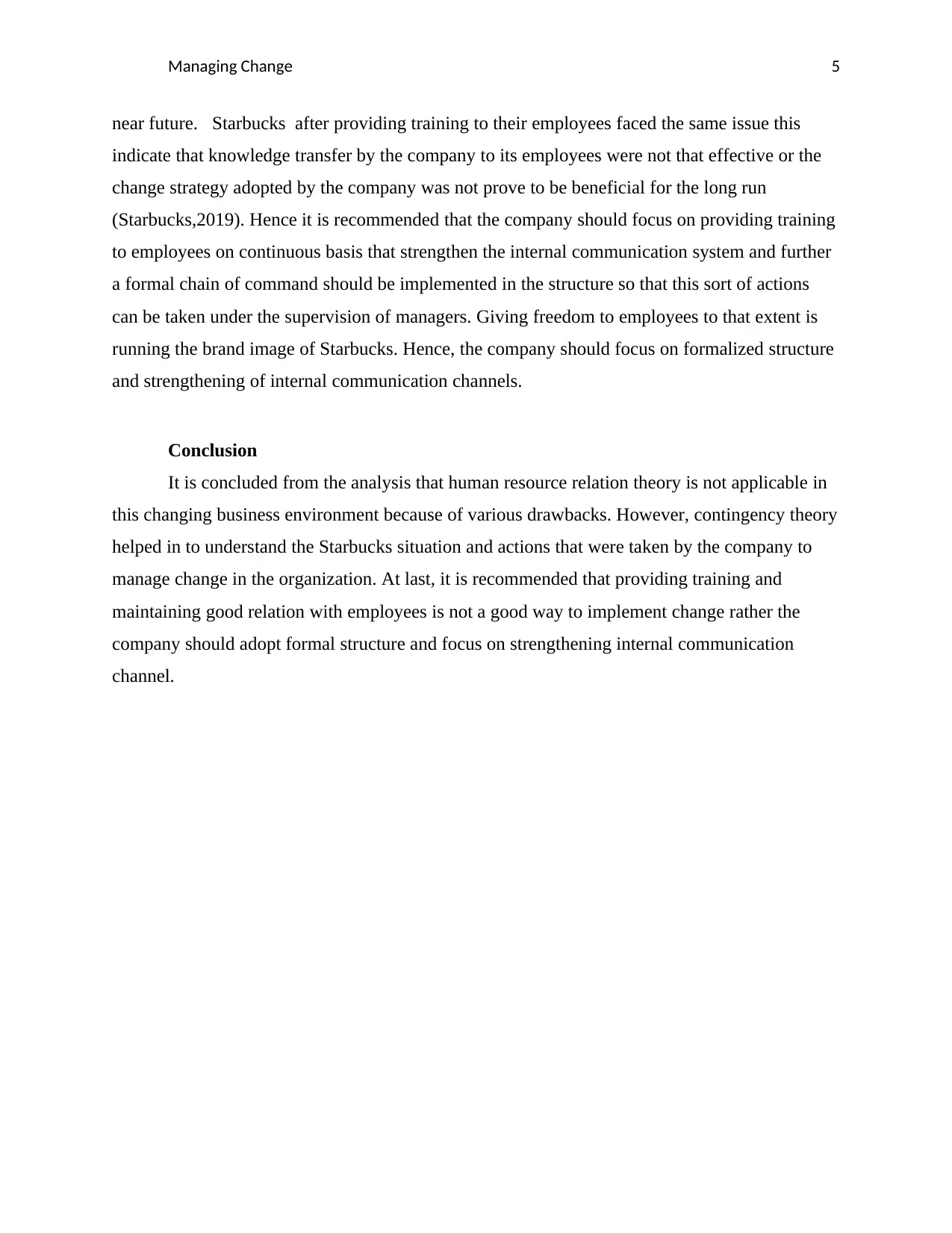
Managing Change 5
near future. Starbucks after providing training to their employees faced the same issue this
indicate that knowledge transfer by the company to its employees were not that effective or the
change strategy adopted by the company was not prove to be beneficial for the long run
(Starbucks,2019). Hence it is recommended that the company should focus on providing training
to employees on continuous basis that strengthen the internal communication system and further
a formal chain of command should be implemented in the structure so that this sort of actions
can be taken under the supervision of managers. Giving freedom to employees to that extent is
running the brand image of Starbucks. Hence, the company should focus on formalized structure
and strengthening of internal communication channels.
Conclusion
It is concluded from the analysis that human resource relation theory is not applicable in
this changing business environment because of various drawbacks. However, contingency theory
helped in to understand the Starbucks situation and actions that were taken by the company to
manage change in the organization. At last, it is recommended that providing training and
maintaining good relation with employees is not a good way to implement change rather the
company should adopt formal structure and focus on strengthening internal communication
channel.
near future. Starbucks after providing training to their employees faced the same issue this
indicate that knowledge transfer by the company to its employees were not that effective or the
change strategy adopted by the company was not prove to be beneficial for the long run
(Starbucks,2019). Hence it is recommended that the company should focus on providing training
to employees on continuous basis that strengthen the internal communication system and further
a formal chain of command should be implemented in the structure so that this sort of actions
can be taken under the supervision of managers. Giving freedom to employees to that extent is
running the brand image of Starbucks. Hence, the company should focus on formalized structure
and strengthening of internal communication channels.
Conclusion
It is concluded from the analysis that human resource relation theory is not applicable in
this changing business environment because of various drawbacks. However, contingency theory
helped in to understand the Starbucks situation and actions that were taken by the company to
manage change in the organization. At last, it is recommended that providing training and
maintaining good relation with employees is not a good way to implement change rather the
company should adopt formal structure and focus on strengthening internal communication
channel.
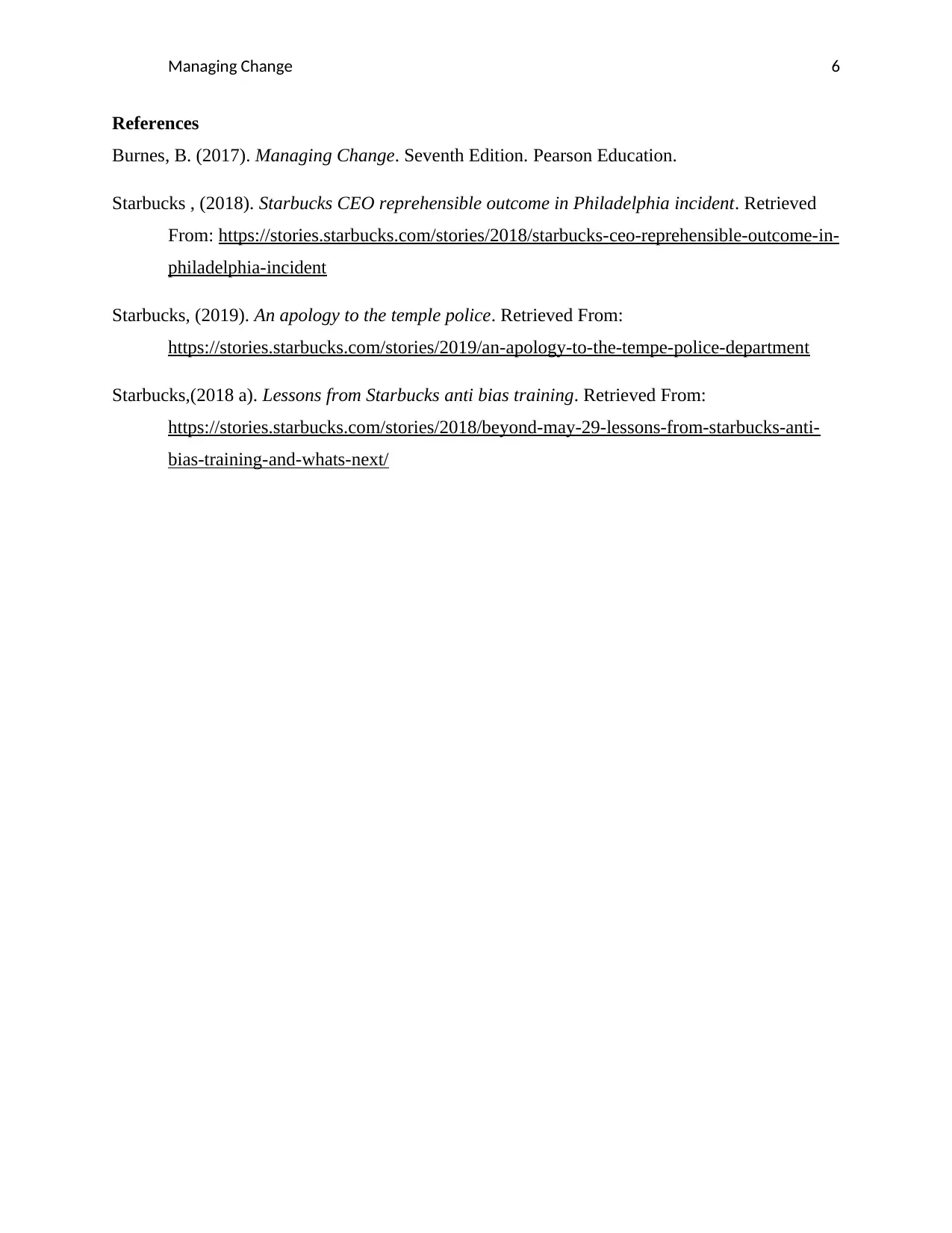
Managing Change 6
References
Burnes, B. (2017). Managing Change. Seventh Edition. Pearson Education.
Starbucks , (2018). Starbucks CEO reprehensible outcome in Philadelphia incident. Retrieved
From: https://stories.starbucks.com/stories/2018/starbucks-ceo-reprehensible-outcome-in-
philadelphia-incident
Starbucks, (2019). An apology to the temple police. Retrieved From:
https://stories.starbucks.com/stories/2019/an-apology-to-the-tempe-police-department
Starbucks,(2018 a). Lessons from Starbucks anti bias training. Retrieved From:
https://stories.starbucks.com/stories/2018/beyond-may-29-lessons-from-starbucks-anti-
bias-training-and-whats-next/
References
Burnes, B. (2017). Managing Change. Seventh Edition. Pearson Education.
Starbucks , (2018). Starbucks CEO reprehensible outcome in Philadelphia incident. Retrieved
From: https://stories.starbucks.com/stories/2018/starbucks-ceo-reprehensible-outcome-in-
philadelphia-incident
Starbucks, (2019). An apology to the temple police. Retrieved From:
https://stories.starbucks.com/stories/2019/an-apology-to-the-tempe-police-department
Starbucks,(2018 a). Lessons from Starbucks anti bias training. Retrieved From:
https://stories.starbucks.com/stories/2018/beyond-may-29-lessons-from-starbucks-anti-
bias-training-and-whats-next/
⊘ This is a preview!⊘
Do you want full access?
Subscribe today to unlock all pages.

Trusted by 1+ million students worldwide
1 out of 6
Related Documents
Your All-in-One AI-Powered Toolkit for Academic Success.
+13062052269
info@desklib.com
Available 24*7 on WhatsApp / Email
![[object Object]](/_next/static/media/star-bottom.7253800d.svg)
Unlock your academic potential
Copyright © 2020–2025 A2Z Services. All Rights Reserved. Developed and managed by ZUCOL.




